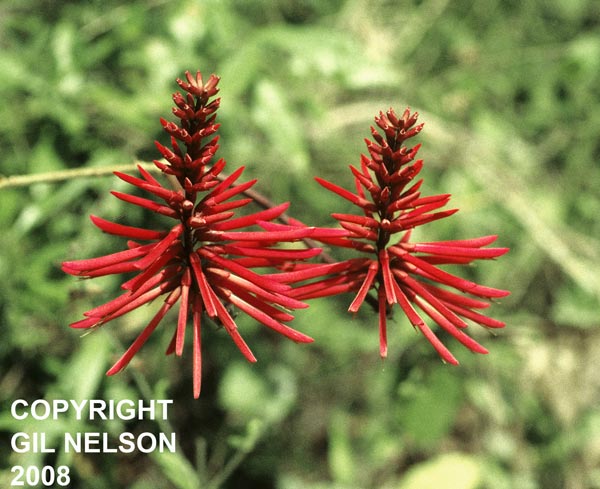Difference between revisions of "Erythrina herbacea"
| Line 27: | Line 27: | ||
===Phenology=== <!--Timing off flowering, fruiting, seed dispersal, and environmental triggers. Cite PanFlora website if appropriate: http://www.gilnelson.com/PanFlora/ --> | ===Phenology=== <!--Timing off flowering, fruiting, seed dispersal, and environmental triggers. Cite PanFlora website if appropriate: http://www.gilnelson.com/PanFlora/ --> | ||
| + | Has been observed flowering from February to June and fruiting from April to August (FSU Herbarium). | ||
| + | |||
===Seed dispersal=== | ===Seed dispersal=== | ||
===Seed bank and germination=== | ===Seed bank and germination=== | ||
Revision as of 15:03, 13 July 2015
| Erythrina herbacea | |
|---|---|

| |
| Photo taken by Gil Nelson | |
| Scientific classification | |
| Kingdom: | Plantae |
| Division: | Magnoliophyta - Flowering plants |
| Class: | Magnoliopsida – Dicotyledons |
| Order: | Fabales |
| Family: | Fabaceae ⁄ Leguminosae |
| Genus: | Erythrina |
| Species: | E. herbacea |
| Binomial name | |
| Erythrina herbacea L. | |

| |
| Natural range of Erythrina herbacea from USDA NRCS Plants Database. | |
Contents
Description
Common Name: Redcardinal, Coral bean, Cherokee bean
Distribution
Ecology
Habitat
Is found in sand pine woodlands, sandy hills, along edges of sinkholes, live oak-cabbage palm forests, uplands, hammocks, flatwoods, sand pine scrub, pine-palmetto scrub near ocean, Longleaf pine-wiregrass savannas, shaded slopes of river bluffs, and in calcareous open prairies (FSU Herbarium). Is also found in human disturbed areas such as along roadsides, in understory of recently clear cut pine woodlands, and edges of woodlands (FSU Herbarium). Can thrive in areas that are shady, semi-shady, or open (FSU Herbarium). Is associated with areas that have sand soil types, sandy loam, loam, thin loamy sand, and calcareous soil types (FSU Herbarium).
Phenology
Has been observed flowering from February to June and fruiting from April to August (FSU Herbarium).